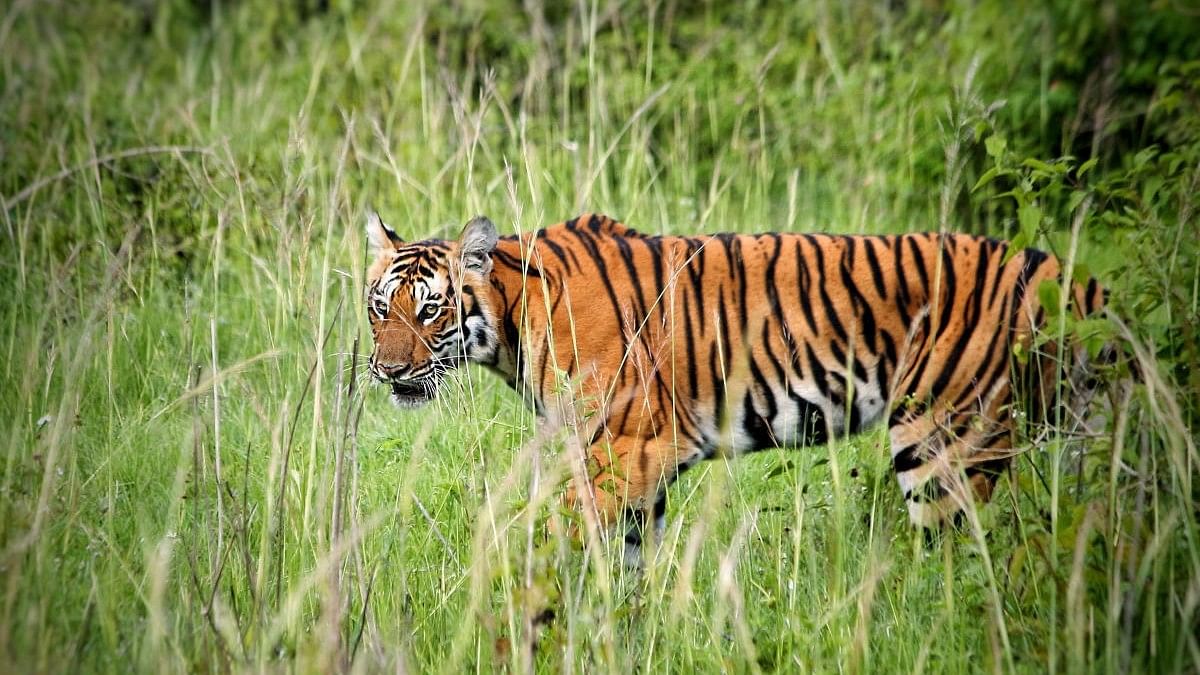
What may be the reason for this spate of tiger kills in Bandipur?
Credit: iStock Photo
There is one more unfortunate death of a tribal as tiger conflicts persist in Bandipur. This is the third tiger killing in these areas this year, with this one coming almost back-to-back. The situation has become rather alarming there.
What may be the reason for this spate of tiger kills?
Generally, tribals and Bandipur tigers have been living
in peace for centuries. Why then is this sudden spurt in these incidents?
For the answer, we have to go back to the devastating fire that engulfed Bandipur National Park a few years ago. More than 10,000 acres of pristine forest were completely gutted, leaving only charred forest floors in the core zone. There was much hue and cry. Even the then-chief minister of the state flew over in a helicopter to assess the damage. It was reported that, due to officials telling him that the coming monsoon would bring the vegetation back alive, the incident was soon forgotten with a few internal inquiries. But did it really happen?
Bandipur Forest, home to mostly moist deciduous forest, is difficult to obliterate, and so there was some greenery immediately after the monsoon, giving everyone a sigh of relief. But the damage had been done irrevocably.
First, the greenery was not the vegetation that supports herbivores, but the dreaded lantana that was flourishing, taking support from
burnt ground, ideal for its unwieldy growth.
Bandipur had already become heaven for this invasive weed. Now the fire gave it more strength. The result is that about half of Bandipur is covered by this woody shrub. This vast sea of lantana does not allow any other natural growth of vegetation. Due to this, there is not enough food for the herbivores, and that has made tigers stray out and indulge in human and numerous cattle kills, as these become easy prey.
Another serious aftereffect of the above fire was a sharp reduction in overall biodiversity, both floral and faunal, thus destroying the semblance of the remaining ecological balance that is so important for the survival of herbivores. Further, the fire had directly affected the number of wild lives that had perished there, besides having long-term effects on their reproductivity, thus contributing to a drastically reduced population of huntable wild prey.
Tigers generally make their kills to optimise the massive effort that goes into one kill; so, it has to be commensurate with the effort in terms of size and health of the prey, which would last for days.
Due to the above fire, the old stock of thriving wildlife was decimated. Thankfully, it is now slowly being revived by nature. But it will take some time to recuperate to the same level if nothing drastic happens again. People get complacent by seeing commonplace spotted deer in Bandipur, but that is not the staple diet for tigers, which prefer bigger games.
Moreover, the water bodies have already started drying up, forcing the normal prey-base animals to move inside, and the resident tiger of these areas has to fall back on whatever gets easily into its territory, be it cattle or unfortunate human beings, as is being seen now.
Another obvious reason is mushrooming structures in the eco-sensitive zone, right under the nose of authorities. This uncontrolled spree, both in Bandipur and across neighbouring Mudumalai forests, has even been noticed by the NTCA, and they had to reach out to the state government to close these unauthorised constructions. But whether it is having any effect is another question.
These structures have completely obliterated the elephant corridor, forcing it to spill over not only in Bandipur but elsewhere too, posing another serious conflict with humans, as seen by us regularly.
Human-wildlife conflict is not only affecting the people in the area but also the staff, who are under tremendous stress and are facing the flak from all corners. Sadly, the approach to tackling these still remains in firefighting mode rather than having a well-oiled permanent strategy and system. Establishing task forces is no doubt a good step that has created confidence among people. But a lot more needs to be done to convert these into professional outfits. It must be done quickly, as the problem is going to get worse in the future. A thorough revamp of management is the need of the hour.
(The writer is a former IFS and PCCF (Head of the Forest Force) officer.)